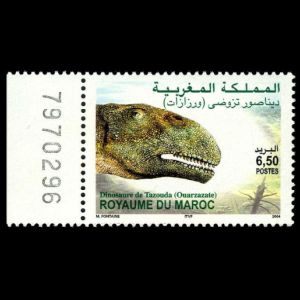the place where Paleontology and Paleoanthropology meets Philately
Morocco
Fossils, dinosaurs and others prehistoric animals on stamps of Morocco
| << previous country | back to index | next country >> |
Contents:
- Country overview
- Philately of Morocco
- Official stamps of Morocco related to Paleontology
- References
- Acknowledgements
Morocco, officially known as the Kingdom of Morocco, is a sovereign country located in the Maghreb region of North Africa.
It overlooks the Mediterranean Sea to the north and the Atlantic Ocean to the west, and has land borders with Algeria to the east, and the disputed territory of Western Sahara to the south.
(Western Sahara issued some stamps, including dinosaurs, in the past, which are not recognized by UPU and are considered illegal.)
Morocco also claims the Spanish exclaves of Ceuta, Melilla and Peñón de Vélez de la Gomera and several small Spanish-controlled islands off its coast.
Geographically, Morocco is characterized by a rugged mountainous interior and large portions of desert. It has Atlantic and Mediterranean coastlines.
Morocco has a population of about 37 million and an area of 446,550 km2. Its capital is Rabat, and the largest city is Casablanca.
A historically prominent regional power, Morocco has a history of independence not shared by its neighbours. Its distinct culture is a blend of Arab, indigenous Berber, Sub-Saharan African, and European influences.
Morocco is a constitutional monarchy with an elected parliament. The King of Morocco holds vast executive and legislative powers, especially over the military, foreign policy and religious affairs. [R1]
The first Moroccan postal stamps were produced in 1891 by private companies which managed courier services between cities.
During the early years of the French Protectorate, as for the other French colonies, stamps bearing the name "MAROC" were produced in Arabic.
Tangier, as an international zone, had a French office which used the stamps of French Morocco labeled with the name of the city.
After the independence in 1956, the kingdom of Morocco regained its postal autonomy. Series of everyday usage were printed with the effigy of the sovereign king of Morocco. [R2]
Official stamps of Morocco related to Paleontology: fossils, dinosaurs and other prehistoric animals
| 18.01.1988 "Dinosaur of Tilougguite" | 12.07.2004 "Dinosaur from Tazouda" | 09.10.2015 "Rocks and Fossils" |
 |
 |

|
References:
- [R1] Morocco: Wikipedia, WikiTravel FlagCounter
- [R2] Postal History and Philately of Morocco:
Wikipedia,
Links to official website of the Post Authority, stamp catalog and a list of new stamps of Morocco are here
Acknowledgements:
Many thanks to Dr. Peter Voice from Department of Geological and Environmental Sciences, Western Michigan University, for the draft page review and his valuable comments.
| << previous country | back to index | next country >> |